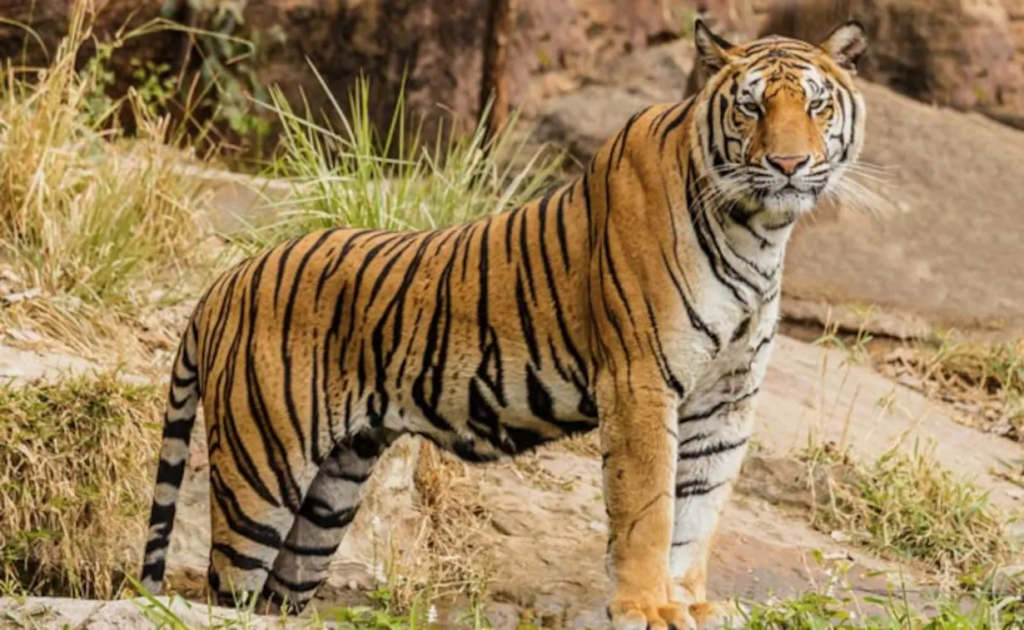TrailGuard AI: Safeguarding Tigers and Communities in India
TrailGuard AI-Introduction:
TrailGuard AI-In the dense jungles of India, a silent revolution is taking place to protect one of the most majestic and endangered species on the planet — the tiger. AI-enabled cameras, specifically the TrailGuard AI developed by the US-based NGO Resolve, are now playing a crucial role in real-time monitoring and protection of tigers, not only against poaching but also in managing human-tiger conflicts. This article explores the innovative features of TrailGuard AI, its successful trials in the Kanha-Pench corridor, and its potential to revolutionize wildlife conservation in India.

TrailGuard AI: A Technological Marvel for Wildlife Conservation:
TrailGuard AI was initially designed to combat poaching, and its first field-test in East Africa in 2018 led to the arrest of 30 poachers, showcasing its efficacy in wildlife protection. However, conservationists in India recognized its potential for addressing the growing human-tiger conflicts in the country. The camera employs an advanced vision chip with embedded AI capable of recognizing up to 10 specific species, including tigers, leopards, elephants, and humans. What sets it apart is its ability to transmit data in real-time to park rangers, providing instant alerts and minimizing response times.
The Kanha-Pench Corridor Trial:
In India’s “tiger state” of Madhya Pradesh, TrailGuard AI was put to the test in a two-month trial in the Kanha-Pench corridor. This region spans over 3,150 square kilometers and houses the Pench Tiger Reserve, the Kanha Tiger Reserve, and a vital forest corridor connecting the two. With a population of over 300 tigers, the corridor is also home to around 600,000 people residing in 715 villages, creating a complex landscape of human-wildlife interactions.
Human-Tiger Conflict Mitigation:
One of the significant challenges in this region is the conflict between tigers and local communities. Tigers often kill livestock, leading to economic losses for villagers and retaliatory killings that negatively impact the already endangered tiger population. TrailGuard AI’s instant transmission of information becomes a lifeline for these communities. When the camera captures an image of a target species, it sends crucial data, including location, time of detection, and the species identified, to forest rangers via email and instant messaging apps.
Creating an Early Alert System:
Piyush Yadav, a conservation technology fellow at Resolve, emphasizes the importance of creating an early alert system. Villagers receive real-time information about the presence of a tiger near their location, allowing them to react more effectively. This proactive approach not only protects human lives but also helps villagers safeguard their livestock. In unavoidable cases of livestock attacks, the captured images serve as evidence for compensation claims, streamlining the compensation process.
Community Tolerance and Conservation Success:
The implementation of TrailGuard AI has demonstrated positive outcomes in fostering coexistence between local communities and apex predators like tigers. Himmat Singh Negi, the former director of Kanha Tiger Reserve, highlights the technology’s success in real-life situations. The ability to prevent potential conflicts and mitigate risks has led to increased tolerance among communities living alongside these apex predators.
Global Need for Human-Wildlife Conflict Mitigation:
The demand for technology that addresses human-wildlife conflicts is not unique to India. In India alone, 35% of the tiger population resides permanently outside designated reserves. TrailGuard AI emerges as a comprehensive tool for managing such conflicts, providing a balance between conservation efforts and the needs of growing human populations.
Trials in Dudhwa Tiger Reserve:
Following the successful trial in the Kanha-Pench corridor, TrailGuard AI underwent a second trial in Dudhwa, a protected area spanning 1,310 square kilometers with around 107 tigers. This trial resulted in the arrest of four poachers attempting to enter the forest after dark. The results, published in the peer-reviewed journal BioScience, showcased an impressive 98.8% accuracy for the cameras. Notably, this marked the first instance of an automatic, AI-enabled camera transmitting images of a wild tiger.
Technological Advancements and Future Deployments:
In response to the successful trials, Resolve has made significant technological advancements in TrailGuard AI. The vision chip in the camera has been upgraded, promising increased accuracy and faster processing. The next phase involves deploying the new cameras in the Kanha-Pench and Dudhwa reserves, as well as West Bengal state, where they will be used in a trial to manage human-elephant conflicts.
Commercialization and Scaling:
The success of TrailGuard AI has led to its commercialization and scaling under a spinout company named Nightjar. The company aims to produce its first run of 500 units by March 2024. Nightjar has already received pre-orders from companies involved in managing wildlife habitats, indicating a strong interest in adopting this technology for broader conservation initiatives.
Tigers as Apex Predators and Ecosystem Stewards:
Tigers play a vital role as apex predators, contributing to the balance and health of forest ecosystems. As the guardians of these ecosystems, their presence sustains livelihoods for countless communities. Piyush Yadav envisions that TrailGuard AI will not only protect tigers but also enable coexistence between tigers and local communities. The understanding among villagers about the essential role of tigers in their ecosystem is crucial for the success of conservation efforts.
Conclusion:
TrailGuard AI stands as a beacon of hope in the realm of wildlife conservation, showcasing how cutting-edge technology can address complex challenges. Its success in India, particularly in the Kanha-Pench corridor and Dudhwa Tiger Reserve, highlights its potential to mitigate human-wildlife conflicts and protect endangered species. As TrailGuard AI continues to evolve and expand its reach, it exemplifies the harmonious coexistence between technology, nature, and communities, providing a blueprint for future conservation endeavors on a global scale.
